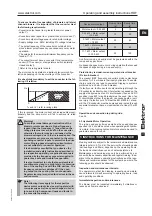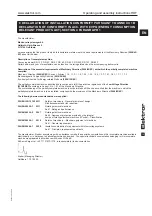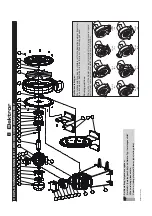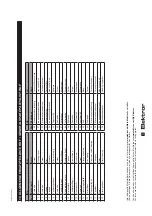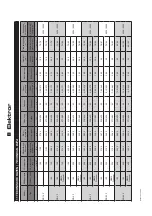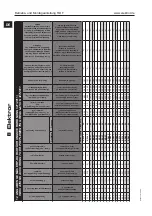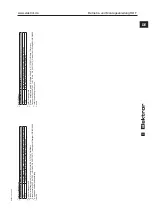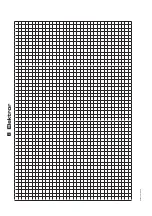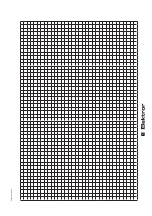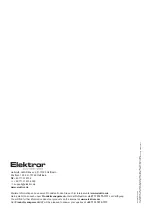
15
EN
Operating and assembly instructions RDF
www.elektror.com
9016315 01.20/12
• Other standards and regulations must be observed
depending on the application.
• Blower feet and consoles must be designed only for the
respective blower’s own weight.
• Cover the open air intake and discharge with protective
grilles according to DIN EN ISO 13857.
• Ensure that the motor has adequate ventilation.
Permitted ambient temperatures with:
Standard model with Elektror motor and a rated voltage of
50 Hz or 60 Hz:
• Ambient temperature -20°C to +60°C
Note!
The rated e
ffi
ciencies and the e
ffi
ciency classes
of the motors are given as per IEC 60034-2-1 for
operation at an ambient temperature of 25°C.
As per IEC 60038 Elektror motors are generally
designed for an extended voltage range of ±10%.
However, the stated e
ffi
ciency relates to the rated
voltage, i.e., the extended tolerance is not taken
into account.
Special voltages, multi-voltage motors, models suitable for
frequency converters, FUK models, devices with UL ap-
proval, devices with Aircontrol and other motor makes:
• Ambient temperature -20°C to +40°C
• Voltage tolerance ±5% (For exceptions, see „4.2 Fre-
quency converter operation“)
• The drive motor ventilation system must not be a
ff
ected
by the installation situation.
Minimum distance to the blower cover (for the intake of
cooling air)
Drive power
Minimum distance
to the blower cover
[mm]
[inches]
≤
1.5 kW
34
1.34
> 1.5 kW
53
2.09
3.3 Electrical connection
Note!
The work described in this section may only be
performed by a quali
fi
ed electrician. Connect ac-
cording to the wiring diagram placed in the termi-
nal box complying with relevant local regulations.
Three-phase or a.c. motors can be used as drive motors.
In the appliance designation, the letter D stands for three-
phase a.c. and the letter E for single-phase a.c.
• The drive motor must be protected using a motor overload
switch (this does not apply to frequency converter oper-
ated appliances). Where appliances are frequency-
converter-operated, the existing temperature sensor (PTC
resistor sensor) or temperature switch (normally closed
contact) must be connected to the converter and evalu-
ated.
• The safety earth terminal can be found in the terminal box.
• Install Electrical ON/OFF switches that can be locked as
maintenance / repair switches.
• Suitable electrical controlling must ensure the blower runs
long enough to clear the line system of any residual media
and avoid its blockage.
• Check that the mains voltage corresponds to the voltage
speci
fi
ed on the nameplate.
Note!
The following information should also be ob-
served when operating the drive motor with a
frequency converter:
• Only motors must be used on the frequency
converter that are marked on the rating plate with
the option “/FU”, “suitable for use with a frequen-
cy converter” or that were ordered and con
fi
rmed
as “suitable for use with a frequency converter”.
• The frequency converter supply voltage must
only be a maximum of 400 V without the motor
fi
l-
ter. Appropriate measures such as a motor
fi
lter to
protect the motor must be installed on the motor
terminals with higher frequency converter supply
voltages, longer lines and/or if the pulse voltages
are exceeded (max. 1000 Vpk for drive motors up
to 0.75 kW, maximum 1300 Vpk for drive motors
larger than 0.75 kW) Please contact the converter
supplier in this case. If a motor
fi
lter is included
in the delivery, this must be installed between
the converter and the motor. Please ensure that
there is su
ffi
cient space in the switch cabinet and
take into account the installation and assembly
requirements in the operating instructions of the
frequency converter/motor
fi
lter manufacturer.
• The maximum cable length between the mo-
tor and switch cabinet frequency converter (e.g.
Lenze Vector, Omron MX2 and Omron RX) must
not exceed 20 m. Maximum cable lengths of up to
3 m are permitted with Kostal INVEOR frequency
converters installed close to the motor and up to
10 m with Lenze MOTEC frequency converters.
Further information on wall mounting close to the
motor can be found in the original operating and
assembly instructions of the respective frequen-
cy converter manufacturer. The electrical con-
necting cables between the motor and frequency
converter in the above cases must be suitable
shielded cables, laid using the shortest route and
without clamping and plug-in connections and
connected correctly at both sides.
• The shielding braid in the connecting cables
must be connected fully, continuously and on
both sides, i.e. to the frequency converter and
motor, and at low resistance and permanently to
protective earthing systems or the main earthing
bus bar. Suitable EMC cable glands must be used
for this on the motor side and also on the INVEOR
wall mounting plate, if necessary.
• It is important to ensure that the solid con-
nection of the device to the protective earthing
system or several suitable earthing lines is at low
resistance and permanent for blowers installed
with electrical insulation (e.g. through vibration
dampers, compensators, insulated pipes, etc.) for
frequency converter operation.
For further information about EMV compliant installation refer
to the operating and assembly instructions of the frequency
converter’s manufacturer.
3.3.1 Con
fi
guration for three-phase current blowers
Warning!
Danger due to loose or improperly tightened con-
nections!
Improperly tightened and loose connections
cause electric shocks,
fi
res, property damage and
personal injuries!
Check for loose connections and tighten in
accordance with the tightening torques in the fol-
lowing table.

















